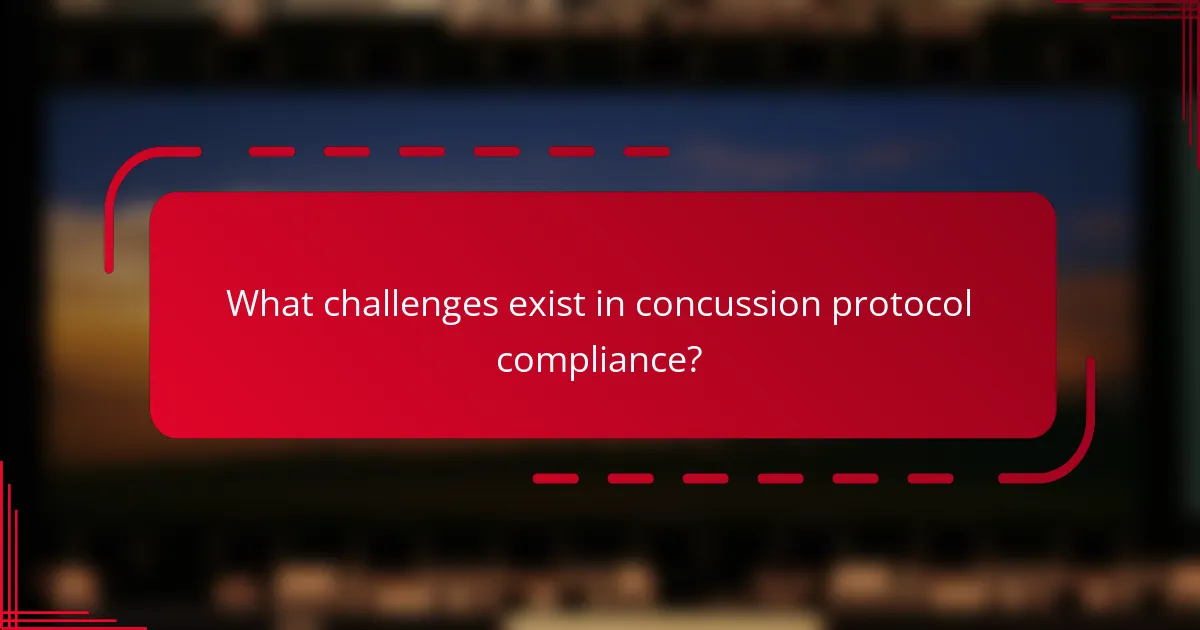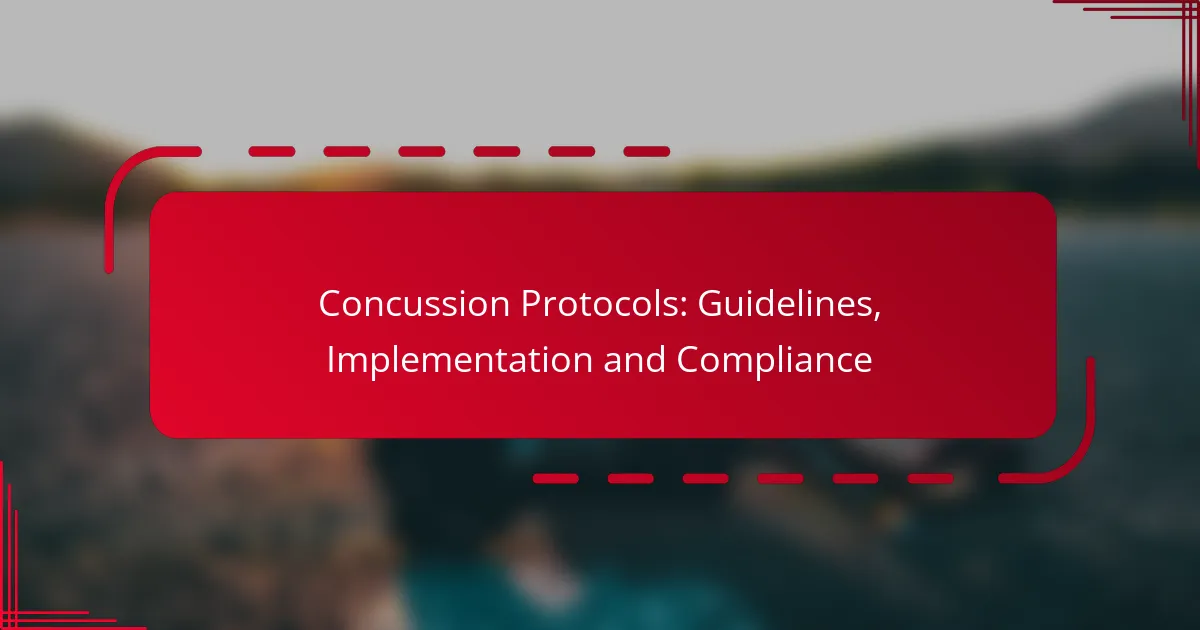Concussion protocols in the United States serve as essential guidelines for managing concussions, particularly in sports settings. These protocols focus on prompt recognition, immediate response, and a structured return-to-play process to prioritize athlete safety. Effective implementation requires clear guidelines, personnel training, and strict adherence to compliance measures, including state laws and monitoring procedures.

What are the concussion protocols in the United States?
Concussion protocols in the United States are guidelines designed to manage and mitigate the effects of concussions, particularly in sports. These protocols emphasize recognition, immediate response, and a structured return-to-play process to ensure athlete safety.
National Federation of State High School Associations guidelines
The National Federation of State High School Associations (NFHS) provides a framework for concussion management in high school sports. Their guidelines require that all coaches, officials, and athletes receive education on recognizing concussion symptoms and the importance of reporting them.
Additionally, the NFHS mandates that any athlete suspected of having a concussion must be immediately removed from play and cannot return until cleared by a qualified healthcare professional. This ensures that athletes receive appropriate care and reduces the risk of further injury.
Centers for Disease Control and Prevention recommendations
The Centers for Disease Control and Prevention (CDC) offers comprehensive recommendations for concussion management, focusing on prevention, recognition, and response. They advocate for the implementation of a “heads-up” approach, which includes educating athletes, parents, and coaches about the signs and symptoms of concussions.
Furthermore, the CDC emphasizes the importance of a gradual return-to-play protocol, which should be individualized based on the athlete’s recovery. This approach helps ensure that athletes do not return to sports until they are fully symptom-free, minimizing the risk of long-term complications.
American Academy of Pediatrics standards
The American Academy of Pediatrics (AAP) has established standards that align with current best practices in concussion management for children and adolescents. Their guidelines stress the need for baseline testing and post-injury assessments to evaluate the severity of a concussion.
The AAP also recommends that schools develop clear policies for managing concussions, including training for staff and access to appropriate medical care. This structured approach helps protect young athletes and promotes a safe sports environment.

How to implement concussion protocols effectively?
Implementing concussion protocols effectively involves establishing clear guidelines, training personnel, and ensuring compliance with best practices. Key steps include educating coaches and staff, creating a management plan, and utilizing baseline testing to monitor athletes’ health.
Training for coaches and staff
Training for coaches and staff is crucial to recognize concussion symptoms and understand the protocols for responding to them. Regular workshops and certification programs can enhance their knowledge and preparedness.
Consider implementing annual training sessions that cover the latest research and guidelines. This ensures that all personnel are up-to-date and can effectively manage any concussion-related incidents.
Creating a concussion management plan
A comprehensive concussion management plan outlines the steps to take when a concussion is suspected. This plan should include protocols for immediate assessment, referral to medical professionals, and a clear return-to-play strategy.
Involve medical personnel in developing this plan to ensure it aligns with local regulations and best practices. Regularly review and update the plan to incorporate new findings and feedback from staff and athletes.
Utilizing baseline testing
Baseline testing is a preventive measure that establishes an athlete’s normal cognitive function before a concussion occurs. This testing can include assessments of memory, attention, and reaction times.
Implement baseline testing at the start of each season, using standardized tools to ensure consistency. This data can be invaluable in determining when an athlete is ready to return to play after a concussion.

What are the compliance requirements for concussion protocols?
Compliance with concussion protocols involves adhering to specific regulations and guidelines designed to ensure the safety of individuals at risk of head injuries. These requirements typically encompass state laws, school district policies, and established monitoring and reporting procedures.
State laws on concussion management
State laws regarding concussion management vary widely, but most require educational institutions to implement specific protocols for handling suspected concussions. These laws often mandate that students be removed from play if a concussion is suspected and that they receive medical clearance before returning to any physical activity.
For example, many states require training for coaches and staff on recognizing concussion symptoms and the importance of following established protocols. Familiarizing yourself with your state’s specific regulations is crucial for compliance.
School district policies
School districts typically develop their own concussion management policies that align with state laws while addressing local needs. These policies often include guidelines for training staff, educating students and parents, and establishing clear procedures for reporting and managing suspected concussions.
It’s essential for schools to regularly review and update these policies to ensure they reflect current best practices and legal requirements. Engaging stakeholders, including parents and healthcare professionals, can enhance the effectiveness of these policies.
Monitoring and reporting procedures
Effective monitoring and reporting procedures are vital for ensuring compliance with concussion protocols. Schools should establish a clear process for documenting incidents of suspected concussions, including the symptoms observed and actions taken.
Regular training sessions for staff on these procedures can help ensure that everyone understands their roles. Additionally, maintaining open communication with parents and healthcare providers can facilitate timely reporting and appropriate follow-up care for affected students.

What are the benefits of following concussion protocols?
Following concussion protocols enhances safety, promotes recovery, and mitigates long-term health risks for athletes. These structured guidelines ensure that individuals receive appropriate care and monitoring after a head injury, ultimately leading to better outcomes.
Improved athlete safety
Implementing concussion protocols significantly improves athlete safety by establishing clear guidelines for identifying and managing head injuries. These protocols often include baseline testing, symptom checklists, and mandatory evaluations by healthcare professionals before an athlete can return to play.
For example, many sports organizations require a trained medical staff member to assess any athlete showing signs of a concussion immediately. This proactive approach helps prevent further injury and ensures that athletes are not prematurely returned to competition.
Reduced long-term health risks
Adhering to concussion protocols can lead to a reduction in long-term health risks associated with repeated head injuries. By ensuring proper diagnosis and recovery time, athletes are less likely to experience chronic issues such as post-concussion syndrome or neurodegenerative diseases later in life.
Research indicates that athletes who follow established protocols are more likely to recover fully from concussions, reducing the risk of complications. Regular education on the signs and symptoms of concussions can further empower athletes to prioritize their health.
Enhanced performance recovery
Concussion protocols facilitate enhanced performance recovery by allowing athletes to regain their physical and cognitive functions before returning to their sport. These protocols often include a stepwise return-to-play process that gradually increases activity levels based on the athlete’s recovery.
For instance, an athlete may start with light aerobic exercise and progress to more intense training only after they are symptom-free. This structured approach not only aids in physical recovery but also helps athletes regain confidence in their abilities, leading to improved performance upon return.

What challenges exist in concussion protocol compliance?
Concussion protocol compliance faces several challenges that hinder effective implementation and adherence. Key issues include a lack of awareness among athletes, inconsistent enforcement by educational institutions, and resource limitations for training staff and coaches.
Lack of awareness among athletes
Many athletes are not fully educated about the symptoms and risks associated with concussions, which can lead to underreporting of injuries. This lack of awareness often stems from insufficient educational programs that fail to engage young athletes effectively.
To improve awareness, organizations should implement regular training sessions and workshops that emphasize the importance of recognizing concussion symptoms. Engaging athletes through interactive methods, such as videos or peer-led discussions, can enhance understanding and retention.
Inconsistent enforcement by schools
Schools often vary in how strictly they enforce concussion protocols, leading to confusion and potential risks for student-athletes. Some institutions may lack clear policies or fail to follow established guidelines, which can compromise athlete safety.
To address this inconsistency, schools should adopt standardized concussion management policies and ensure that all staff are trained in these protocols. Regular audits and assessments can help maintain compliance and identify areas needing improvement.
Resource limitations for training
Many schools and sports organizations face budget constraints that limit their ability to provide adequate training for coaches and staff on concussion protocols. This can result in a lack of knowledge about proper procedures for managing concussions.
To overcome resource limitations, schools can seek partnerships with local health organizations or utilize online training resources that are often available at little to no cost. Allocating funds specifically for concussion education can also enhance overall safety and compliance.

How do concussion protocols vary by region?
Concussion protocols differ significantly across regions, influenced by local laws, educational policies, and healthcare practices. These variations can affect how concussions are managed in schools, sports, and healthcare settings.
Differences in state legislation
State legislation plays a crucial role in shaping concussion protocols. Many states have enacted laws requiring specific procedures for identifying and managing concussions in youth sports. For instance, some states mandate that athletes suspected of having a concussion must be removed from play and cannot return until cleared by a healthcare professional.
These laws often vary in terms of the age groups they cover, the definitions of a concussion, and the required training for coaches and staff. States like California and Texas have comprehensive laws, while others may have minimal requirements, leading to inconsistencies in how concussions are handled.
Variations in school district policies
School district policies on concussion management can differ widely, even within the same state. Some districts implement strict protocols that align closely with state laws, while others may adopt more lenient approaches. This can include variations in the training provided to coaches and staff regarding concussion awareness and response.
Additionally, schools may have different procedures for returning to play and academics after a concussion. For example, some districts may require a gradual return to physical activity, while others might allow immediate participation if symptoms are absent. Parents and guardians should familiarize themselves with their local district’s policies to ensure proper adherence to concussion management practices.
